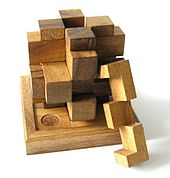Wooden toys
| "Old wooden toys" ( welfare stamps of the German Federal Post Office 1971) |
|
 Women at the churn |
 equestrian |
 Nutcracker |
 Pigeon house |
As wooden toys or commercial sense as Wooden toys completely or mostly from is wood -made toy called.
history
Along with bones and stones, wood is one of the oldest materials and can therefore also be found in the manufacture of toys. The history of wooden toys is closely linked to the development of mankind and was often a reflection of the prevailing art eras . In ancient Egypt , 200 BC, children mainly played with wooden animal figures. Young Greeks and Romans of antiquity devoted themselves alongside gyroscopes , dice games and the like preferred playing with wooden swords . Many visual artists took up the topic.
In many regions, the manufacture of wooden toys was often the main source of income. Historical wooden toys in particular are and have always been a topic for exhibitions and museums, such as the Erzgebirge Toy Museum Seiffen , the Wooden Toy Museum Bad Münstereifel or the Steinacher Toy Box Museum . The Val Gardena Museum houses a unique collection of old Val Gardena wooden toys from the period 1750 to 1940, which Johann Senoner-Vastlé brought together before the Second World War.
Manufacturing
In general, it is important in production that wood is used as the main component. Different types of wood can be used. A wide variety of wood processing techniques are also possible. Furthermore, it is not important whether it is wood that has already been processed or raw wood , since both are allowed for the production of a wooden toy. In many cases, the raw material wood also enables defective toys to be repaired.
safety
For wooden toys, just like any other type of children's toy, the European Union Toy Directive applies . Since this is a general guideline of the European Union, it is valid for all states that belong to the European Union. Wooden toys that do not comply with these guidelines are not considered safe children's toys and may not be brought into circulation, traded by private dealers or exported by states. It is about the pollutant content, parts that small children can swallow or the avoidance of dangers when handling and breaking. Another relevant safety aspect is fire protection or the required low flammability. According to the Toys Directive, replicas of historical toys, imitations of real firearms and bows over 120 cm in length are not considered toys.
The Stiftung Warentest has examined 2,013 wooden toys for toddlers to security in years and had 16 of the 30 products tested objectionable. The origin of the products classified as dangerous was not geographically correlated. In addition to detaching parts that could be swallowed, toxic and carcinogenic substances were found in paint and plywood, the concentration of which was above the limit values. Stiftung Warentest also criticizes the limit values for carcinogenic substances specified in the toy directive as being too high in some cases, as they are based on adults and children are more sensitive.
Products
The range of wooden toys is diverse. In addition to classic toy variants such as wooden dolls , wooden trains , doll kitchens , toy cars , wooden building blocks , construction toys (z. B. Baufix ), etc. are often board games and puzzles and toys such as table football and table alleys made of wood. In addition to professional or industrial production, wooden toys are also often made by do-it-yourselfers for their own use. There is a wide range of literature with instructions for in-house production.
In the Ore Mountains in particular , the manufacture of wooden toys developed into an important source of secondary income due to the financial hardship that prevailed in the past and the abundance of wood in the region . In order to be able to manufacture small wooden figures more economically through mass production, the technique of turning tires was developed in this area at the beginning of the 19th century .
The Berchtesgadener War was produced from the end of the 15th to the beginning of the 19th century in the area of the prince-provost of Berchtesgaden . A traditional example of these products is the ass pipe horse, originally intended as a children's toy and later also used as a Christmas tree ornament .
Matryoshkas are particularly well known in Russia .
Many well-known toy manufacturers have or had wooden toys in their range. For example, the master carpenter and inventor of the Lego blocks, Ole Kirk Christiansen, began with wooden toys. The soft toy manufacturer Steiff also had wooden toys in its range from time to time.
pedagogy
The toys developed by Friedrich Fröbel are mostly made of wood. They should train creativity and fine motor skills as well as spatial thinking.
Others
In Germany, wooden toy maker is a state-recognized training occupation. The profession of skilled worker for wooden toys already existed in the GDR .
The German Design Prize for wooden toys has been awarded in Germany since 1993 .
See also
literature
- Manfred Bachmann : Wooden toys from the Ore Mountains. Verlag der Kunst, Dresden 1984.
Web links
Individual evidence
- ↑ Alfried Schmitz: Games and Toys - History of Toys , Planet Knowledge , from December 30, 2010.
- ↑ Directive 2009/48 / EC (PDF, 1029 kB).
- ↑ https://www.test.de/Holzspielzeug-Die-Haelfte-birgt-Gefahren-4633745-0/ Stiftung Warentest: Wooden toys: Half are dangerous , published on November 21, 2013, accessed on Jan. 2, 2020
- ↑ Joseph Ernst von Koch-Sternfeld: History of the Principality of Berchtesgaden and its salt works. Volume 3.
- ↑ Ordinance on professional training as a wooden toy maker. on: gesetze-im-internet.de , (PDF; 47 kB), accessed on October 12, 2010.



